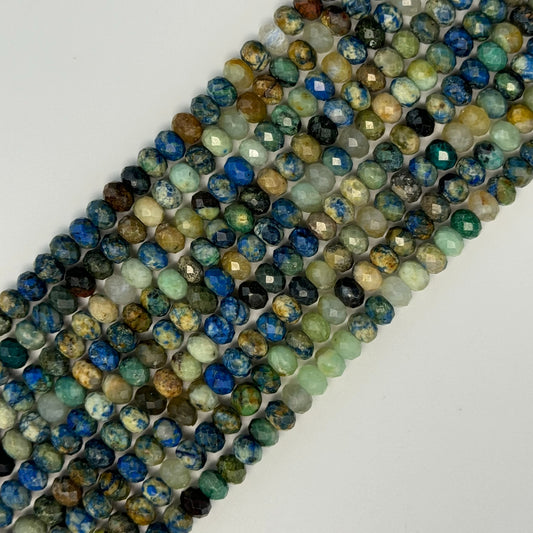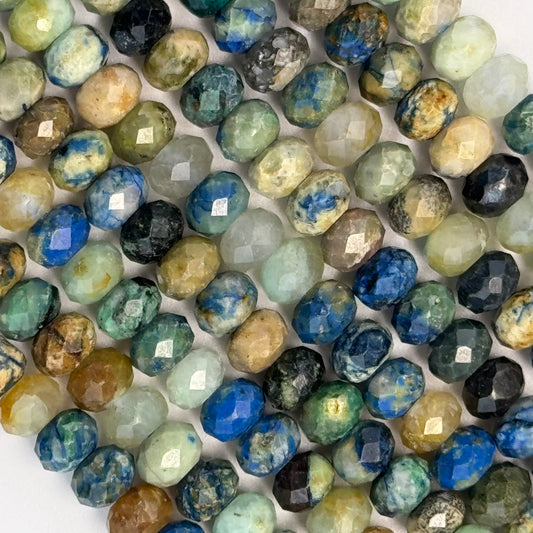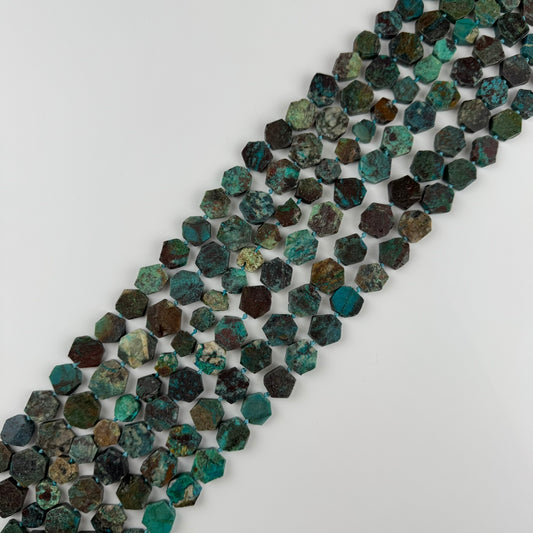Azurite and Chrysocolla Gemstone Beads
Azurite
Azurite is a deep blue copper carbonate mineral with the chemical formula Cu₃(CO₃)₂(OH)₂. It forms through the weathering of copper ore deposits and is often found alongside malachite. Its intense azure colour is due to copper content, making it highly valued in gemology, mineral collections, and pigments historically used in art.
Azurite Crystal
Azurite crystals form as monoclinic prismatic or tabular structures, displaying a vibrant blue with vitreous lustre. They commonly occur in botryoidal, stalactitic, or massive habits, often intergrown with malachite, forming azurite-malachite specimens prized by mineralogists and collectors.
Azurite Meaning
In metaphysical traditions, azurite is regarded as a stone of insight, wisdom, and deep spiritual attunement. It is believed to stimulate the third eye chakra, enhancing intuitive perception, psychic abilities, and inner vision for meditation and energy work practices.
Azurite Healing Properties
Azurite is said to relieve mental stress and confusion, facilitating clear thinking and concentration. Practitioners use it to alleviate migraines, promote detoxification at the cellular level, and aid throat and joint health due to its copper content influence in energetic healing modalities.
Azurite Color
Azurite exhibits a vivid azure to deep blue hue, attributed to copper ions absorbing and reflecting light in the visible spectrum. Its blue colour may fade with prolonged exposure to sunlight or heat, transitioning into malachite over geological time as hydration increases.
Azurite Beads in Jewelry Making
Azurite beads are widely used in jewelry for their rich blue colour and natural patterns. They are typically stabilised or treated to enhance durability as azurite has a Mohs hardness of 3.5–4, making it softer than many gemstones. Jewelry artisans often combine azurite beads with malachite, turquoise, or silver findings to create vibrant necklaces and bracelets.
Due to its softness, azurite is best suited for earrings, pendants, and beads that do not endure heavy abrasion. Its unique colour provides an elegant contrast in gemstone bead strands and designer pieces.
Stabilised azurite maintains its appearance longer, preventing the powdering or fading of colour common in untreated specimens. High-grade azurite beads are prized by collectors and designers for their natural aesthetic and historical significance as a pigment stone.
When used in jewelry making, azurite evokes both scientific interest for its mineral properties and spiritual appreciation for its metaphysical resonance, making it a sought-after material in artisan and holistic jewelry design.
Azurite Ring
Azurite rings showcase its striking deep blue colour, often cabochon cut and set in sterling silver. Due to its softness, care is required to avoid scratching during wear.
Azurite Bracelet
Azurite bracelets typically use stabilised or bead forms to provide durability. They are worn for their metaphysical properties related to intuition and wisdom while adding a bold blue statement to any attire.
Azurite Necklace
Azurite necklaces feature beads, cabochons, or azurite-malachite combinations for unique, earthy designs. They are popular in metaphysical jewelry collections and as mineralogically significant adornments.
Frequently Asked Questions
What is azurite?
Azurite is a copper carbonate hydroxide mineral with the formula Cu₃(CO₃)₂(OH)₂, known for its intense deep blue colour. It forms through the weathering of copper ore deposits and is often associated with malachite.
What is the hardness of azurite?
Azurite has a Mohs hardness of 3.5 to 4, making it a relatively soft gemstone, suitable for beads, pendants, earrings, and collector specimens but requiring careful handling in jewelry settings.
What is azurite used for?
Azurite is used in mineral collections, jewelry making, and historically as a blue pigment in paintings before synthetic alternatives became widespread.
What is azurite malachite?
Azurite malachite is a mineral combination where azurite’s deep blue is intergrown with malachite’s green, forming attractive banded or mottled specimens used in beads, cabochons, and carvings.
What colour is azurite?
Azurite is known for its vivid azure to deep blue colour, resulting from copper ions absorbing light within the visible spectrum. Over time, it can weather into green malachite through hydration processes.
What are azurite's metaphysical properties?
Azurite is believed to enhance intuition, stimulate the third eye chakra, improve mental clarity, and support spiritual awakening in crystal healing practices.
Where is azurite found?
Major azurite deposits are found in copper mining regions worldwide, including Morocco, the USA (Arizona, Utah), Namibia, Australia, and Mexico.
How is azurite formed?
Azurite forms through the oxidation of copper ore deposits in the presence of carbonated water, creating its characteristic blue crystals in cavities, fractures, or as crusts.
Can azurite be used in jewelry?
Yes, azurite is used in jewelry, particularly as beads, cabochons, pendants, and earrings. Due to its softness, stabilisation treatments are sometimes applied for durability.
What are azurite beads?
Azurite beads are spherical or faceted cuts of azurite used in jewelry making. At Reza Gem Collection, we offer natural azurite beads in various sizes for custom jewelry design and gemstone collections.
How should I care for azurite jewelry?
Azurite should be kept away from prolonged sunlight, heat, and acids. Clean with a soft cloth and avoid ultrasonic or steam cleaners to maintain its colour and integrity.
What is the spiritual meaning of azurite?
Spiritually, azurite is known as the “Stone of Heaven,” facilitating deep meditation, psychic development, and inner wisdom for those who practice metaphysical healing.
Is azurite rare?
While azurite is not extremely rare, high-quality crystals, large specimens, and vibrant blue bead-quality materials are highly valued by collectors and jewelers.
What shapes do azurite beads come in?
At Reza Gem Collection, azurite beads are available in round, faceted round, and rondelle shapes, often combined with malachite for a unique colour mix in designer jewelry pieces.
Does azurite fade over time?
Yes, azurite can fade or transform into malachite over geological time through weathering and hydration, so it is important to protect it from sunlight and moisture exposure.
What is the chemical composition of azurite?
Azurite’s chemical composition is Cu₃(CO₃)₂(OH)₂, classifying it as a basic copper carbonate mineral within the carbonate group.
How is azurite different from lapis lazuli?
Although both are blue, azurite is a copper carbonate mineral with deeper azure tones, while lapis lazuli is a metamorphic rock composed mainly of lazurite, with pyrite inclusions giving it a golden flecked appearance.
What are azurite malachite beads?
Azurite malachite beads combine blue azurite and green malachite in natural patterns, creating beautiful beads used in necklaces and bracelets at Reza Gem Collection for a vibrant earthy aesthetic.
Why choose azurite beads from Reza Gem Collection?
Reza Gem Collection offers high-quality natural azurite beads sourced directly from reputable mines, ensuring authenticity, rich colour, and exceptional craftsmanship for jewelry designers and gemstone enthusiasts.
How can I use azurite beads in my jewelry designs?
Azurite beads can be used as focal beads in necklaces, combined with sterling silver findings for elegant bracelets, or as accents in spiritual jewelry collections to harness their metaphysical properties.





















